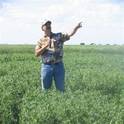
Sustainable management practices are needed to enhance soil productivity in degraded dryland soils in the northern Great Plains. We examined the effects of two tillage practices [conventional till (CT) and no-till (NT)], five crop rotations [continuous spring wheat (Triticum aestivum L.) (CW), spring wheat-fallow (W-F), spring wheat-lentil (Lens culinaris Medic.) (W-L), spring wheat-spring wheat-fallow (W-W-F), and spring wheat-pea (Pisum sativum L.)-fallow (W-P-F)], and a Conservation Reserve Program (CRP) on plant biomass returned to the soil, residue C and N, and soil organic C (SOC), soil total N (STN), and particulate organic C and N (POC and PON) at the 0- to 20-cm depth. A field experiment was conducted in a mixture of Scobey clay loam (fine, smectitic, frigid Aridic Argiustolls) and Kevin clay loam (fine-loamy, mixed, superactive, frigid Aridic Argiustolls) from 1998 to 2003 near Havre, MT. Mean annualized plant biomass returned to the soil from 1998 to 2003 was greater in W-F (2.02 Mg ha−1) than in W-L and W-W-F, regardless of tillage. In 2004, residue cover was greater in CW (60%) than in other rotations, except in W-W-F. Residue amount and C and N contents were greater in NT with CW (2.47 Mg ha−1 and 963 and 22 kg ha−1, respectively) than in NT with W-L and CT with other crop rotations. The POC at 0 to 5 cm was greater in W-W-F and W-P-F (2.1–2.2 Mg ha−1) than in W-L. Similarly, STN at 5 to 20 cm was greater in CT with W-L (2.21 Mg ha−1) than in other treatments, except in NT with W-W-F. Reduced tillage and increased cropping intensity, such as NT with CW and W-L, conserved C and N in dryland soils and crop residue better than the traditional practice, CT with W-F, and their contents were similar to or better than in CRP planting.
Available at: http://works.bepress.com/andrew_lenssen/19/
